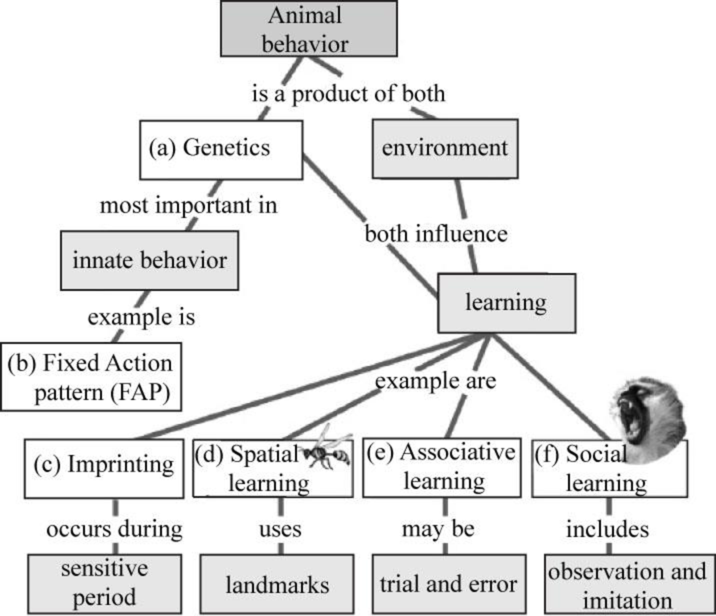
Concept explainers
To complete: The given map that reviews the genetic and environmental components of animal behavior and their relationship to learning.
Introduction:
The action of behavior is carried by the muscles that are in control of the nervous system in response to environmental stimulus. Thus, the behavior of animal is the response from internal and external environmental stimulus.
Explanation of Solution
Pictorial representation:
Fig.1 shows the completed map that reviews the genetic and environmental components of animal behavior and their relationship to learning.

Fig.1: Components animal behavior and their relationship to learning.
(a)
Correct answer: Genetics.
The animal behavior is a combined effect of genetics and environment and both influence the learning in animals. However, genetics is the main cause of innate behaviors. Hence, the correct answer is genetics.
(b)
Correct answer: Fixed Action pattern (FAP).
FAP is an unchangeable series of action caused by a particular stimulus. Hence, the correct answer is FAP.
(c)
Correct answer: Imprinting.
Imprinting is the sensitive phase that occurs after the hatching of the young ones. The first person that the young ones see will imprint with them like the hatched newborns see their mother; so, they follow her in a straight line whenever she goes for a walk. Hence, the correct answer is imprinting.
(d)
Correct answer: Spatial learning.
Spatial learning is the memories of landmarks created by animals with in their environment. The landmarks include trees, water, and mountains to find their way to home. It helps them to find a mate, food, nest, and possible dangers. The landmarks include trees, water, and mountains to find their way to home. Hence, the correct answer is spatial learning
(e)
Correct answer: Associative learning.
Associative learning is the association of result with a particular action by animals like while training a dog an individual feeds them with treats on performing well in training so they associate the food with the behavior while they learn. Hence, the correct answer is associative learning.
(f)
Correct answer: Social learning.
Social learning is the learning from other’s behavior by just watching or observing them. In an experiment, many octopus were put through the maze, while one is going in the maze, the others were tend to watch and the next time when they perform, they remember the path and finish it within less time. This concludes that the animals watch and learn from other’s behavior for a particular situation. Hence, the correct answer is social learning.
Want to see more full solutions like this?
Chapter 35 Solutions
Campbell Biology: Concepts and Connections
- series of two-point crosses were carried out among six loci (a, b, c, d, e and f), producing the following recombination frequencies. According to the data below, the genes can be placed into how many different linkage groups? Loci a and b Percent Recombination 50 a and c 14 a and d 10 a and e 50 a and f 50 b and c 50 b and d 50 b and e 35 b and f 20 c and d 5 c and e 50 c and f 50 d and e 50 d and f 50 18 e and f Selected Answer: n6 Draw genetic maps for the linkage groups for the data in question #5. Please use the format given below to indicate the genetic distances. Z e.g. Linkage group 1=P____5 mu__Q____12 mu R 38 mu 5 Linkage group 2-X_____3 mu__Y_4 mu sanightarrow_forwardWhat settings would being able to isolate individual bacteria colonies from a mixed bacterial culture be useful?arrow_forwardCan I get a handwritten answer please. I'm having a hard time understanding this process. Thanksarrow_forward
- Biology How many grams of sucrose would you add to 100mL of water to make a 100 mL of 5% (w/v) sucrosesolution?arrow_forwardWhich marker does this DNA 5ʹ AATTGGCAATTGGCAATTGGCAATTGGCAATTGGCAATTGGCAATTGGC 3ʹ show?arrow_forwardThe Z value of LOD for two genes is 4, what does it mean for linkage and inheritance?arrow_forward
- Biology How will you make a 50-ul reaction mixture with 2uM primer DNA using 10 uM primer DNA stocksolution and water?arrow_forwardBiology You’re going to make 1% (w/v) agarose gel in 0.5XTBE buffer 100 ml. How much agarose are you goingto add to 100 ml of buffer? The volume of agaroseis negligible.arrow_forwardBiology How will you make a 50-ul reaction mixture with0.2 mM dNTP using 2-mM dNTP stock solution andwater?arrow_forward
 Biology (MindTap Course List)BiologyISBN:9781337392938Author:Eldra Solomon, Charles Martin, Diana W. Martin, Linda R. BergPublisher:Cengage Learning
Biology (MindTap Course List)BiologyISBN:9781337392938Author:Eldra Solomon, Charles Martin, Diana W. Martin, Linda R. BergPublisher:Cengage Learning Biology: The Dynamic Science (MindTap Course List)BiologyISBN:9781305389892Author:Peter J. Russell, Paul E. Hertz, Beverly McMillanPublisher:Cengage Learning
Biology: The Dynamic Science (MindTap Course List)BiologyISBN:9781305389892Author:Peter J. Russell, Paul E. Hertz, Beverly McMillanPublisher:Cengage Learning Comprehensive Medical Assisting: Administrative a...NursingISBN:9781305964792Author:Wilburta Q. Lindh, Carol D. Tamparo, Barbara M. Dahl, Julie Morris, Cindy CorreaPublisher:Cengage Learning
Comprehensive Medical Assisting: Administrative a...NursingISBN:9781305964792Author:Wilburta Q. Lindh, Carol D. Tamparo, Barbara M. Dahl, Julie Morris, Cindy CorreaPublisher:Cengage Learning Human Heredity: Principles and Issues (MindTap Co...BiologyISBN:9781305251052Author:Michael CummingsPublisher:Cengage Learning
Human Heredity: Principles and Issues (MindTap Co...BiologyISBN:9781305251052Author:Michael CummingsPublisher:Cengage Learning Human Physiology: From Cells to Systems (MindTap ...BiologyISBN:9781285866932Author:Lauralee SherwoodPublisher:Cengage Learning
Human Physiology: From Cells to Systems (MindTap ...BiologyISBN:9781285866932Author:Lauralee SherwoodPublisher:Cengage Learning





